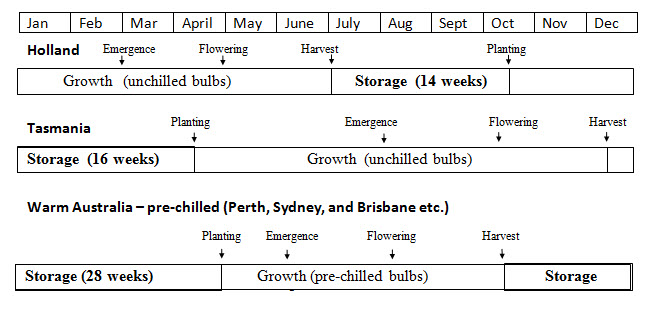Since the bulbs are alive at all times, it follows that the conditions encountered during storage will affect the subsequent crop. Further, continual respiration during prolonged storage will result in exhaustion of the bulbs resources to the point, eventually, where the bulb will not perform well or even grow at all.
In order to keep alive, the bulb must respire. This process involves the conversion of sugar to energy and in the process oxygen in “breathed in” and carbon dioxide and water “breathed out”.
Of particular interest to bulb growers are the two main products of respiration, namely carbon dioxide (CO2 ) and water (H2O). The fact that CO2 is liberated is evidence of loss of carbohydrate and therefore energy reserves in the bulb. Every day the bulb is in store it is becoming a little bit weaker.
Likewise, the liberation of water from the bulb through both respiration and surface evaporation means that every day the bulb is in store it is becoming al little more de-hydrated.
Study of this necessary respiration thus highlights the importance of good bulb storage. Bulbs must be stored with adequate air movement and ventilation or they will be unable to get rid of the CO2, H2O and ethylene liberated and will thus perform poorly during subsequent growth and possibly become infected with Penicillium. Excessive heat or air movement, however, will speed respiration and thus the degeneration of the bulb.
This becomes especially important in growing areas where the summers are long and hot. By way of example, consider the following situations for Tasmania, Holland and a warm Australian location using pre-chilled bulbs. (NB: Tasmania and Holland - unchilled bulbs)

NB: The above times are approximate but are used to make an important point about the very long storage time involved especially when harvesting bulbs from pre-chilled bulbs in warm Australian locations.
The very long storage times (over 6 months) for pre-chilled bulbs grown in hot summer climates means there is a great deal of respiration between bulb harvest and re-planting with the result that the bulbs are inevitable weakened (loss of water, loss of energy) as compared to bulbs stored for a shorter period.
1. Flower Abortion
Sustained high temperatures after flower initiation (about 8 weeks from lifting) will lead to significant risk of bud abortion. It is difficult to quantify exact temperatures to cause this, especially in bulbs exposed to normal daily temperature fluctuations. However, a rule of thumb may be that regular exposure to temperatures above 30 degrees is likely to induce this condition. The prevalence of air conditioning in Australian homes now gives some control over this.
2. Bulb Splitting
High temperatures after some weeks of storage lead to increased chances of bulb “splitting”. Splitting describes the increase in the number of bulbs harvested per bulb from those planted and the subsequent decrease in size of the harvested bulbs. The actual cause of this is hormonal change which reduced the apical dominance in the bulb.
Apical dominance describes the ability of the major bulblet to appropriate the available energy to itself and thus grow in preference to the other bulbs. The amount of apical dominance is dependant on the variety as well as the conditions. Varieties such as Ad Rem and quite a few of the single lates have naturally high apical dominance (ie. produce a small number of large bulbs) while other varieties (e.g. Angelique) have low apical dominance and thus produce a larger number of smaller bulbs. Usually, a moderate amount of apical dominance is desirable thus producing large bulbs for flowering in the following year.
It is difficult to quantify the effects of temperature fluctuation on bulbs stored in ambient conditions. Obviously, the temperature changes constantly due to both daily cycle and prevailing weather.
It can be said with confidence, however, that the growth and performance of bulbs stored in controlled temperature conditions will be significantly better and more reliable than if the bulbs are stored outside, and that these advantages will be over and above avoiding the potential high temperature effects noted above.
An important principle of bulb storage should always be kept in mind: bulbs should be stored at continually lowering temperatures - never raise the storage temperature - keep it steady or lower it.
The obvious conclusion from the above analysis is that year-on-year tulip bulb production in warm climates is exceedingly difficult. The good news is that tulip bulb prices in Australia are now much less than half the cost in the mid-1980’s and so their use as annuals is now possible for many people.
Use as an Annual
As an annual in warm climates, most varieties of tulips can be grown but the stronger varieties are best and those suitable for warm climates are still the most recommended.
For Those Determined!
The problem as has been described is the long storage time. Storage = respiration = energy loss and shrinkage = disease risk and poor performance. Flowers in the second year are difficult (but not impossible), after that the problems compound as flowering in the second year is likely to be in June with senescence in August!
Therefore, the task is to minimise storage time and maximise conditions for quality storage.
Options are limitless but obviously the average home gardener has limited infrastructure for controlled bulb storage at different temperatures. In approximate order of simplicity, the following is suggested:
Among the varieties we recommend for warm climates, there is a group of single lates known as the Scheepers hybrids which will grow with no special cold at all. Planting in e.g. Sydney in a pot in the shade would be enough. This would result in slower growth and thus shorter storage next summer and more success.
These varieties are Maureen, Avignon, Halcro, Maja, Burgundy Lace, Menton, and Renown. We have not tested all of these in Sydney unchilled but we do have confidence that Maureen, Maja and Menton will perform in this way. Similar results would be expected in Perth and Brisbane.